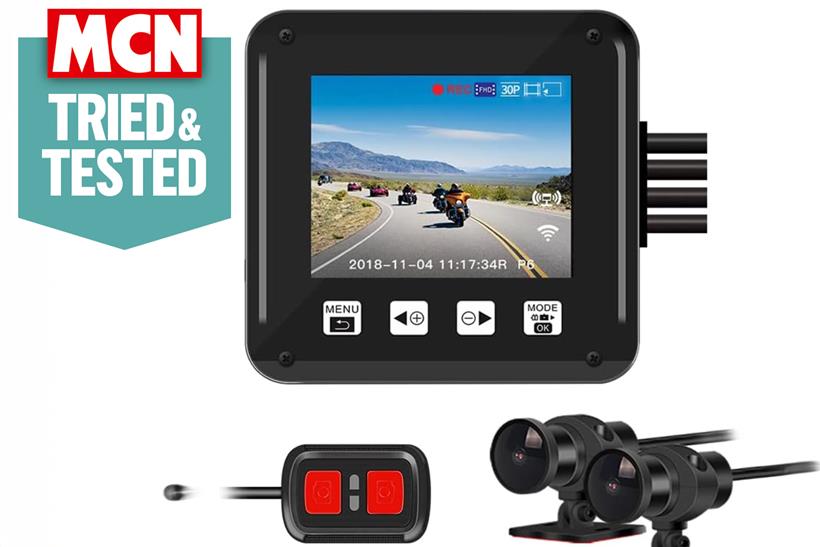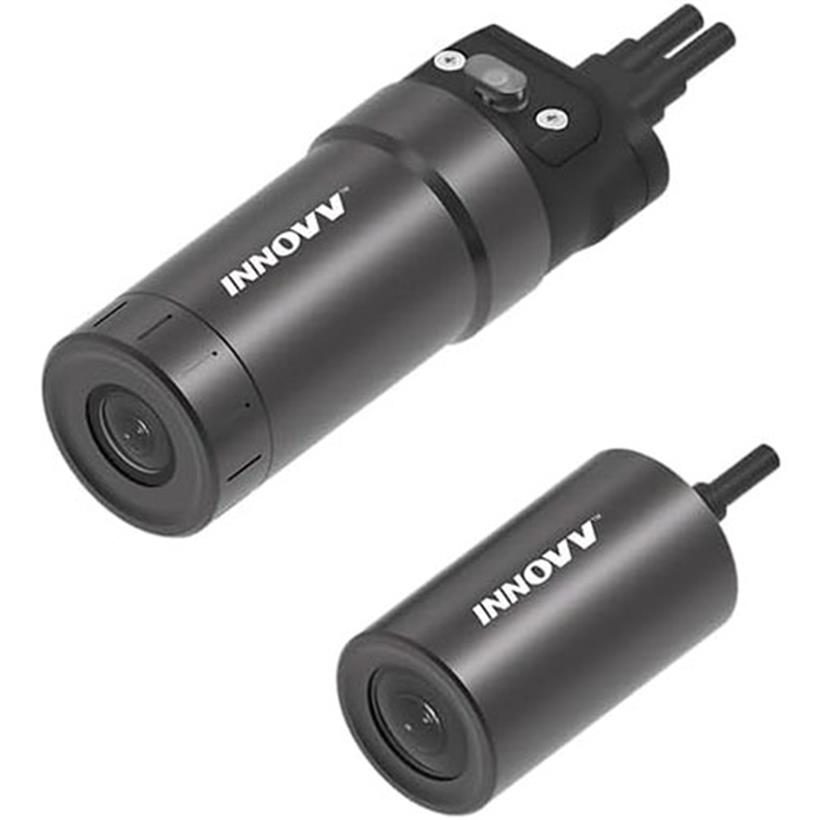Motorcycle dash cam buying guide | These high-tech video cameras give you added peace of mind

Motorcycle dash cams are just as crucial for capturing incidents and proving innocence as automobile dash cams, yet most motorcyclists don’t bother. Until they wish they had.
Jump to:
- What exactly is a dash cam?
- Types of motorcycle dash cams
- How are dash cams different from action cameras?
- Should I have a dash cam on my bike?
- How do I choose the best dash cam?
- Vsysto dash cam reviewed
- Other dash cams to consider
- Choosing a dash cam
- Dash cam accessories
- How MCN tests dash cams
- Rating scores explained
What exactly is a dash cam?
For those not familiar, ‘dash cam’ is short for ‘dashboard camera’ and is a nickname for what is officially known to the authorities as a “Driving Recorder”.
A dash cam on your bike will record what happens on the road around you continuously as you ride. It turns on and begins recording automatically when you power up your motorcycle, and it goes off when you turn the ignition off. The recording loops, so when the memory card is full it goes back to the beginning and overwrites the old files.
If you want to keep what’s been recorded just take the memory card out, download the footage onto your computer, then put it back into the dash cam unit. Modern dash cams have GPS tracking, night vision, and audio recording.
Types of motorcycle dash cams:
Most dash cams fall into one of these categories:
- Single channel – record the footage in front of your bike
- Dual channel – record the footage in the front and rear
- 360-degree – either 1 x 360-degree camera, or multiple separate cameras that provide an all-round view of your surroundings as you ride
Some action cameras also have a ‘dash cam’ option. They use less battery power in this setting and record continuously as you ride. I would still choose a dedicated dash cam over this option because I don’t want to be switching between settings when I want to capture some awesome footage on my action camera.
How are dash cams different from action cameras?
We use action cameras mainly to capture specific events on a particular ride. They are mounted either somewhere on ourselves, our helmet, or our bike. We turn them on to capture what we want then turn them off to save battery power.
Motorcycle dash cams, however, record whatever happens in front and behind you every time you fire up the engine. They are permanently installed and get their power from the bike’s battery whilst you’re riding. Ideally you’d install the cameras to discreet areas on the bike so they would be less likely to attract attention of thieves. They also have more stable and secure mounts and are purpose-built to withstand vibrations and shocks.
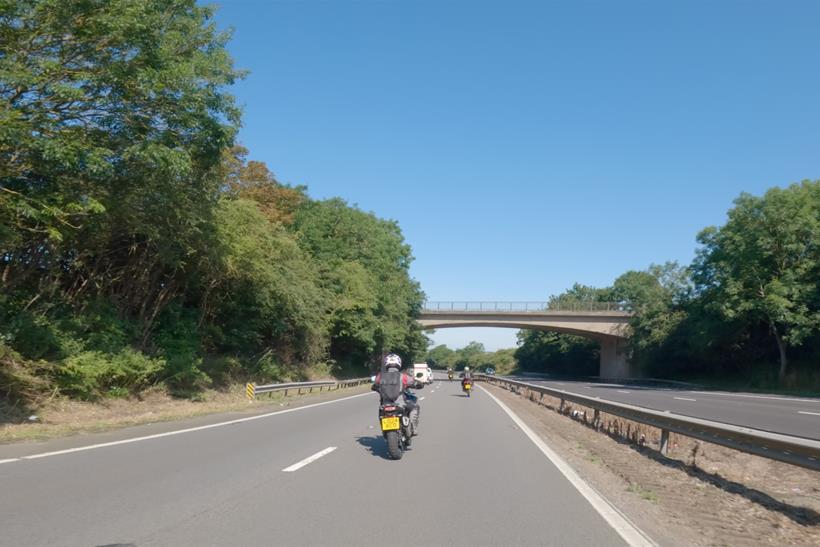
A dash cam that has GPS tracking enabled is like a little ‘black box’ on your bike. This could be vital in the event of an incident. Some also have a parking mode which activates a motion sensor in the camera if a car bounces into your bike when it’s parked, or if someone tries to make off with your pride and joy while you’re asleep.
Motorcycle dash cams usually have larger lenses and better sensors than action cameras. They can adapt to different lighting conditions and capture images in more detail, including at night or in bad weather.
Should I have a dash cam on my bike?
The unexpected happens on just about every ride and that’s why motorcyclists must be more aware of their surroundings than other road users. If it ever became necessary, video evidence of an incident would be irrefutable in most situations, and would be acceptable to insurance companies and the courts.
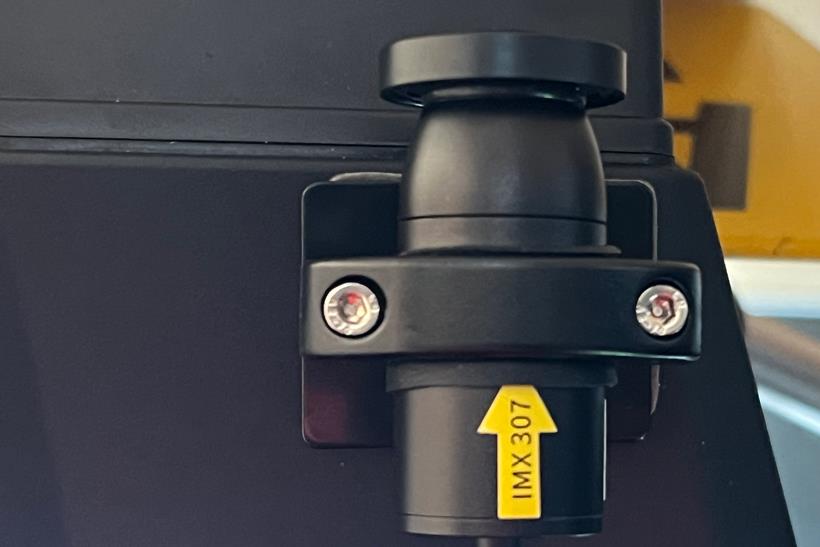
Here are some of the pros and cons of having a dash cam on your bike:
Pros:
- Records your ride from beginning to end
- Provides video evidence if there are any incidents along the way
- Can help speed up claims if you’re not at fault
- May protect you against fraudulent insurance scams
- Can reduce insurance premiums in some cases
- Captures the unexpected – good or bad
- Encourages safer riding
- If you have an ‘always-on’ dash cam you can check on your bike at anytime via the app on your phone
Cons:
- If you have an ‘always-on’ dash cam make sure it doesn’t drain your battery
- Dash cams are illegal in some European countries, such as Austria and Portugal
- They can be seen as an invasion of privacy in some situations
- Some dash cams are quite expensive
- Depending on where it’s placed it can be a distraction as you ride
- They can work against you if you are at fault in an accident
- If your dash cam is on display it can attract thieves
How do I choose the best dash cam?
Consider if you want cameras at the front, front and back, or 360 degrees, and where they might fit discreetly on your bike. The better the video quality the more expensive the unit will be, so check out the options available. Remember that the memory card is usually sold separately and will add to the cost.
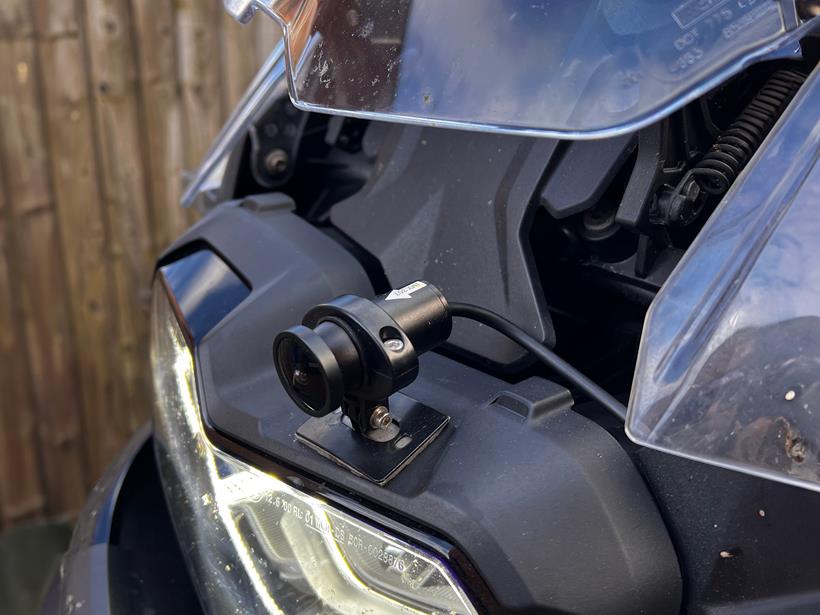
It’s worth getting a dash cam that connects to an app so you can access video recordings and change settings remotely on your smartphone. GPS tracking is also a useful feature. You can set it to track your entire route and record information such as speed and location. This information can then be used to create reports or provide evidence in the event of an incident on the road.
Ultimately, it’s worth investing in a quality dash cam. Not only will it provide you with peace of mind while riding, but it could also save you money if you ever need to file an insurance claim or are involved in a legal dispute.
Reviewed – the Vsysto Dash Cam
This dashcam from Vsysto is Amazon's Choice for 'motorcycle dashcam' and gets pretty good user reviews on the site. It uses two 150° wide angle lenses and records in 1080P HD resolution to a microSD memory card, which has a capacity of up to 256GB.
It loop-records video into one, two, three or five-minute clips and a handy button will capture and keep the footage from one minute before it is pressed, so an incident can be captured. It has a built-in G-sensor to register impacts and Wi-Fi connectivity means you can view footage on the device through an app on your smartphone.
Read our full review of the Vsysto Dash Cam
Pros
- Has glass lenses and Sony image sensors (not cheap plastic)
- The recordings are clean and clear
- The system itself is fairly easy to install - it's obviously bike dependent as to how easily the cameras can be sited and the cables routed through the bodywork
- You can connect the unit to your phone via a dedicated app
Cons
- The camera brackets are a bit flimsy in older versions so get the most updated version
- The wires connecting to the battery are straightforward, but the third wire that controls the on/off function with the ignition is a bit more fiddly
| Portable: | No, hardwired |
| Lens angle: | 150° |
| Lenses: | 6-layer all glass |
| Resolution: | 1080P |
| Card included: | No |
| GPS logging: | No (add-on available) |
| Smartphone connectivity: | Yes |
| Waterproof rating: | IP67/IP65 |
- Super Night Vision
- IMX323 image sensors
- Can connect to mobile phone in real time via dedicated app
- Accepts memory card up to 256GB
Other dash cams to consider
He said: "Fitted to the bike as one forward camera and one rear, the system is knitted together by a WiFi-enabled controller that can let you view, manage the settings, and download photos and video clips direct from the Innovv App on your phone/device. No internet required, no cables, no card-juggling.
"The control unit holds a Micro SD memory card (a 256 GB will swallow 19hrs of footage before it rewrites itself), but anything you download remains in the App until you export or delete it. You can also choose whether to use GPS map overlay and speed information – or not."
You might also consider the all-singing, all-dancing Innovv K7 for the ultimate in current tech from the firm.
Pros
- Dual-camera setup provides front and rear coverage for comprehensive recording
- WiFi-enabled controller facilitates wireless viewing, managing settings, and downloading via the Innovv app
- Supports micro SD cards up to 256 GB, capable of storing 19 hours of footage before overwriting
- Offers optional GPS map overlay and speed information for enhanced data tracking
- User-friendly app keeps downloaded files until manually exported or deleted
Cons
- Needs wiring into the bike
- Need to have suitable camera mounting points
| Portable: | No, hardwired |
| Lens angle: | 120° |
| Lenses: | Two |
| Resolution: | 1080P |
| Card included: | No |
| GPS logging: | Yes |
| Smartphone connectivity: | Yes |
| Waterproof rating: | IP67 |
- Waterproof
- Connects wirelessly with phone
- Front and rear cameras
The main sensor is made by Sony, and there is a wired remote control to lock a recording, start or stop recording or take a snapshot. It has GPS recording as well as a G-sensor that locks the recorded footage if it detects an impact.
Pros
- The cameras and main unit are both waterproof to different levels
- Connects to a dedicated app on your phone
- Can download footage from your phone without having to take out the memory card
- The video quality is very good
Cons
- The SD card slot isn't as easy to access as others
- the wifi app sometimes crashes when downloading footage from the phone
| Portable: | No, hardwired |
| Lens angle: | 150° |
| Lenses: | Two |
| Resolution: | 1080P |
| Card included: | No |
| GPS logging: | Yes |
| Smartphone connectivity: | Yes |
| Waterproof rating: | IP67 |
- Both cameras use SONY IMX323 sensor and have 6-layer glass lens and F1.8 large aperture
- 5.0 megapixel HD shooting
- 1080P/30fps seamless recording
- The main device, accessories and cable lines support IP65 level waterproofing
- The front and rear cameras support IP67 level waterproofing
- Connects wirelessly to your phone vie dedicated app
- 150 degrees ultra-wide field of view
Things to consider when choosing a dash cam:
Weatherproofing
It goes without saying that a dashcam for a motorcycle needs to be a fairly different beast to one intended for a car. On a bike, the lenses certainly will be exposed to the elements, and the main recording unit will also suffer from vibrations, for example, during use. So the lenses needs to be fully waterproof and the main unit vibration-proof and ideally waterproof as well, especially when using it as a helmet camera.
Lenses
The lenses are the eyes of the system, and there is a compromise here; a wide-angle lens will catch the action from all around the bike, while a narrower one will highlight detail farther away. Many regard a lens angle of around 170° as ideal for use with a dashcam since this will capture as much information from around the bike as possible. And while some systems use a single camera lens, others use two, one at the front and one at the rear to provide information about rear-end impacts, for example.
Integrated or separate lenses
Some motorcycle dashcams are single, integrated units and work standalone, ie with a power supply but no other connection. Others use a central recording unit and separate lenses that can be positioned around the bike. Ultimately the choice is up to you, but the former is more transferable, i.e. you can potentially use it on several bikes, while the latter would be hard-wired to the bike and would stay with it. In addition, the lenses would be smaller and less obtrusive than mounting a complete camera on the bike.
Video resolution
Like the angle of the camera, the greater the video resolution, the more information will be available in your recordings. Details such as vehicle numberplates or identification of people is much easier the higher the resolution. Ideally, you’d want 4k resolution, but as an absolute minimum, you should be looking for 1080P. Alongside the resolution is the frame rate, which can affect how accurate the footage is in terms of its ability to identify key data. 30 Frames per Second (fps) is generally the minimum you should be looking for.
Logging
Some units come with built-in GPS tracking that can help identify the location of any incidents where video evidence is necessary. They can potentially confirm your speed and travel and can also serve as a journey log for later use or to share with other riders.
Recording
Whether you use a dedicated motorcycle dashcam or improvise with an action camera, you need to be recording in loop mode, so this is what you need to look for on an action camera. This effectively fills up the memory card and, once full, deletes the oldest footage and overwrites it with the newest, so the card is always full of the last period of riding, depending on your card’s capacity. Also, remember to turn it on and start recording – this may well be automatic with hard-wired systems, but you will probably need to do it yourself on smaller units or action cameras.
Smartphone connectivity
Some systems – particularly those with hard-wired recoding units – will have a corresponding smartphone app that will allow you to monitor the video recordings or live-view the camera lenses so that you can position them correctly and download video from a main unit.
G-sensor
Some systems have accelerometers, or g-sensors, built in which will sense an impact and automatically store the video footage from a pre-set period before this impact as well as following it.
Accessories to consider
Once you have chosen your dashcam, there are several other accessories that you might need to consider to get the most from it.
Memory card
Inevitably most dashcams will record onto a memory card, and some will specify a maximum size of card. We would always recommend buying a branded version and the highest speed possible, particularly if you are using a high-resolution camera and lenses, to ensure you capture and keep all the relevant details from your rides. Most are likely to be a microSD format with an adapter to allow you to remove the card and download footage to your computer easily.
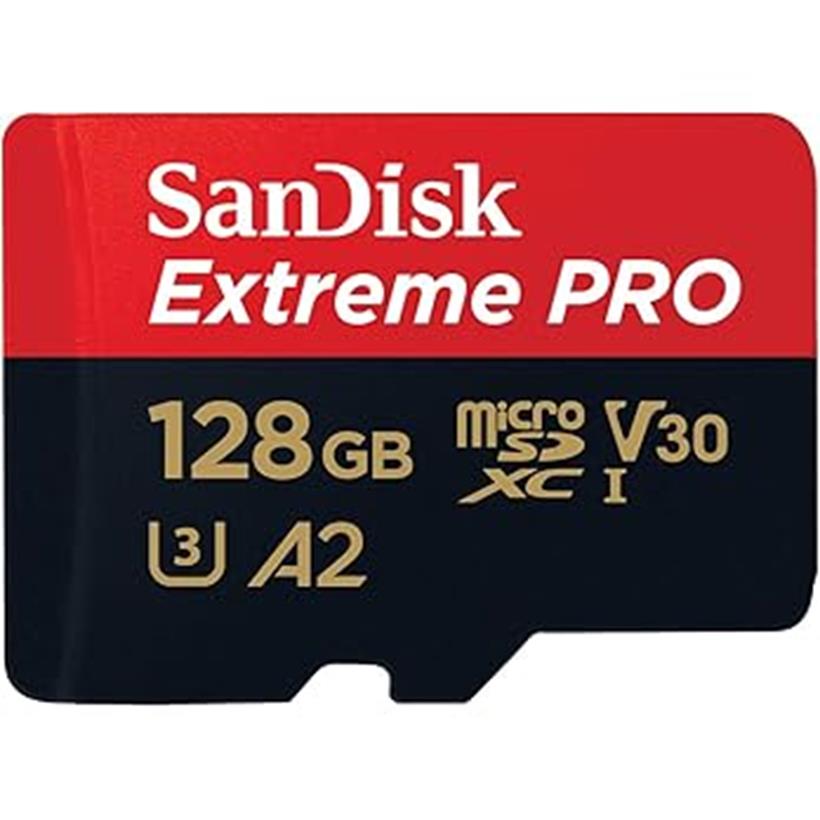

Power solution
While hard-wired systems that use a central recording unit will be permanently connected to the bike’s battery, if you are using a more portable device, then you may need to make sure it is always charged ready for each ride. For an action camera mounted to the bike, you may be able to power this up from an accessory or USB socket in use but bear in mind that many action cameras don’t have waterproof charging options.
Mounting bracket
Permanent systems will generally mount a lens at the front to cover the full view ahead. Similarly, a rearview will do the same. If you are using a standalone dashcam or an action camera, then you will need to mount it to the bike so that it captures the full view yet does not interfere with your view of the road ahead. You also need to ensure that it is mounted securely and won’t move around in use – it is no use if you rely on some video evidence and the camera is shaking so much you cannot make out the necessary details.
Cleaning cloth
Clearly a camera covered in road grime is of no use, so keep the lens(es) clean with a wipe over with a damp cloth between washing the bike as a whole.
How MCN tests dash cams
At MCN, our team of expert journalists have decades of experience gained over hundreds of thousands of miles. We don’t test our kit to destruction; we use it exactly how you do, in the real world and in all conditions. That means we can deliver impartial buying advice you can rely on. Each of our writers has an in-depth understanding of the needs of today’s biker… because they are one. Our mission is to help you stay informed, make great buying decisions and most important of all, to enjoy your motorcycling to the fullest.
When we test dash cams we ride with them for at least 1000 miles and a minimum of three months before beginning to write a review. We install them on our own bikes and get to know the dash cam we’re testing inside and out. We use all the functionality, and learn what’s good about them and what’s not from what we’ve experienced. In testing all of its features in every scenario possible – rain, night time, poor visibility and more – we are able to pass this information on to our fellow riders.
We’ll share our feedback on everything from what the unit is capable of through to the installation process and all our experiences on the road with it, and back at home looking at ways the footage can be used and how useful their dedicated phone apps turn out to be.
It’s worth noting that we only test products that we believe will be useful for our readers. There are quite a few dash cams on the market – particularly online – that appear to be inferior technology and we don’t want to waste your time or ours.
I wanted to test the new Vsysto unit because previous versions have been popular and well regarded by other riders. I’ve never used a dash cam before and it’s going to be a bit of an adventure for me.
I’ve just installed the new Vsysto dash cam on my BMW 850 GSA and will post my review when I’ve put the miles and months in with it. We’ll also be doing a more in-depth review of the popular Innovv K6 Dual Lens Dash Cam.
Our rating scores explained
When we review a product, we award it a score out of five. In the ratings tab of a given product, you may also find more specific scores for the different aspects of a product’s performance to help you make an informed decision. Here’s a guide to what each number score means:
- 1 star – Poor performance in this category or overall. A product with a single star rating has fallen below the expected standard and should be avoided.
- 2 stars – Basic performance in this area or overall. A product with a two-star rating has managed to perform to a barely acceptable level and there is room for improvement.
- 3 stars – An average performance in this area or overall. A product with a three-star rating has achieved a basic level of performance and is deemed adequate.
- 4 stars – A product has performed over and above the accepted averaged in this category or overall. A product with a four-star rating has surpassed expectation and delivered in a particularly impressive way.
- 5 stars – A product has performed at the highest possible level in a particular category or overall. A product with a five-star rating has delivered to the highest possible level, impressing the tester with its performance. We would happily spend our own money on it.
- Just so you know, we may receive a commission or other compensation from the links on this website - read why you should trust us.
